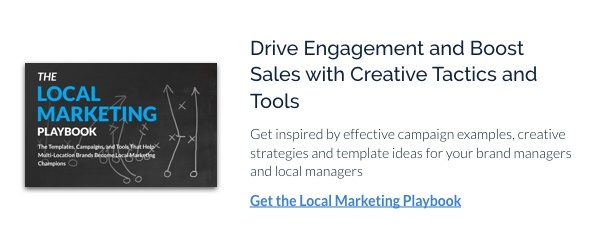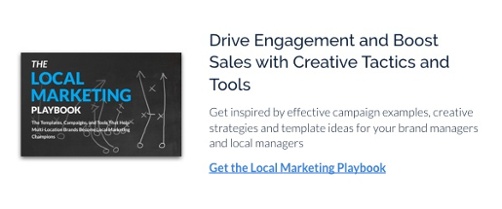The local customer experience (CX) is a key concern for Chief Marketing Officers (CMOs), according to a soon-to-be-published new, 2017 Local Marketing Automation Adoption Trends survey report by Pica9. Among executives and leaders at distributed brands (organizations with a corporate marketing function that oversees a network of local distributors and business owners), 93 percent report that improving customer experience for brand growth has been a major area of investment over the last 12 months.
As marketing leaders at distributed brands focus on product innovation and local customer experiences as a tool for better marketing return on investment (ROI), research reveals that many are focused on achieving streamlined local marketing execution. Improving operational efficiency is the chief concern for 52 percent of distributed enterprise organizations, and 96 percent of these leaders view automation-based technology as a key tool for cost-savings and superior local marketing execution.
Read on to learn why today’s distributed CMOs are recognizing the value of improving customer experience on a local level, investing in faster local marketing execution, using fewer tools, and pivoting their strategies accordingly.
5 Key Areas of Investment for Distributed Local Marketing
Area #1: Improving Local Customer Experience
While 93 percent of distributed brand leaders cite improving the local customer experience as a key strategic priority, research reveals that CMOs perceive many different barriers to this goal. Survey results reveal a variety of concerns surrounding challenges to better customer communications at the local level, including:
- 81% of CMOs report challenges related to a lack of local marketer expertise
- 70% of CMOs are concerned with poor brand consistency
- 65% of CMOs are struggling to effectively manage omni-channel messaging
Research has also revealed that the most effective organizations recognize the value of the local marketer’s perspective in developing high-performing local marketing messages. Brands that produce the highest-quality customer experiences are more likely than their peers to develop means of tighter collaboration between the corporate marketing team and local representatives so they can achieve highly-relevant local executions.
The key to success in local marketing in 2017 is supporting local affiliates and enabling them to create brand-compliant, hyper-localized advertising – campaigns that create immediate relevancy for the customer and fresh, interesting impressions of the brand. Forward-thinking CMOs at distributed enterprises recognize the value of new marketing ideas coming from their local outlets, and are focusing their investment on tools to enable the creation of locally-driven marketing.
Area #2: Improving Time to Technology Value
Ten years ago, many CMOs were investing heavily in custom-built technologies they maintained in-house. Today, 60 percent of marketing leaders report that they’re seeking a “faster pace of adoption” as a lever for a superior time-to-value ratio. The most effective enterprise brands are significantly more likely to invest in software-as-a-service (SaaS) applications instead of custom or on-premise solutions to improve the rate at which technologies are adopted.
Consumer preferences for communication channels are changing rapidly. What was considered relevant in 2014 may be completely irrelevant for the same audience segment in 2017. With custom software development projects often taking years to achieve full implementation, CMOs are realizing that SaaS apps can be a better investment when the goal is to get up and running quickly.
A key metric of success for many MarTech initiatives in 2017 is speed of implementation, or the time required to begin driving ROI from a new platform. The need for agility in enterprise technology is a key underpinning to Gartner’s recent announcement of MRM 2.0; an acknowledgment that Marketing Resource Management systems are increasingly being split out into more agile apps specifically designed for work management, asset management, and performance management.
Few distributed enterprise organizations can afford to invest heavily in a custom-built local marketing system that may not be able to adapt quickly to the changing demands of their customers — or proves difficult for local marketers to use. Instead, lightweight, cloud-based tools allow enterprises to begin driving value quickly with software investments and pivot when necessary. SaaS apps are driving numerous benefits for early adopters, including:
- Simplified maintenance and automatic feature updates
- Faster implementation and instant access to features
- Ease-of-use and global access
- Reduced dependence on internal IT resources
- Global access and mobility
Area #3: Reducing Niche Tools
The average distributed brand is using eight different technologies to support local marketing. While using a broad portfolio of tools may appear to support these brands' technology requirements, there’s always a risk of miscommunication that increases with the number of platforms in use. 71 percent of respondents acknowledged that too much tech can do more harm than good, indicating that tool consolidation across both corporate and local marketing efforts is critical to the customer experience.
For today’s distributed brands, poorly-integrated or excessive marketing tools can create local and corporate marketing liabilities, which include:
- No System of Record: Using redundant or excessive technology can lead to a lack of consistency and mass confusion around “the right” content and designs for local marketing campaigns. Risks of operating without a single source-of-truth can include poor asset utilization, duplicated efforts, or local marketing campaigns that go off-script due to confusion about which assets are the right ones.
- Inefficient Auditing: Auditing local marketing efforts is significantly more time-consuming when local marketers are using five or six different applications, while a single application can improve corporate visibility into local executions.
- Adoption: Excessive tooling may significantly deflate local adoption rates as local affiliates struggle to learn all of the platforms required, or switch between tools with inconsistent marketing results.
The outcome of the above points — no system of record, inefficient auditing, and adoption — is a loss of brand consistency. Because redundant technology limits brands' ability to use the same content in multiple systems, local outlets end up using branded content unevenly. This leads to a real lost opportunity — brands with more consistent messaging and customer experiences have up to 20 percent higher brand value than their counterparts. For CMOs of multi-location brands in 2017, it’s clear that the solution for better marketing performance isn’t more technology — it's having the right tools for the right purpose.
Area #4: Print Marketing
96 percent of distributed marketing leaders report that their most-desired feature from local marketing automation (LMA) technologies is customized print marketing templates. With studies showing that print advertising can carry a 38 percent higher ROI than broadcast media even in today's fractured media landscape, print remains a very effective channel for distributed brands.
Unlocking the full potential of print for localized marketing creates an impactful customer experience that drives response from customers and increases local marketing ROI. Modern consumers are 78 percent more likely to sort through direct mail than open branded emails. Print marketing is tangible and multi-sensory in ways that digital marketing isn’t; and print materials support information retention and retrieval in ways that elicit a direct response from local customers.
Many of today’s smartest CMOs realize the value of technology investments into local print marketing efforts. Functionality like print templating supports the local marketer’s need to customize templates into small batch prints for in-store advertising, targeted direct mail campaigns, rack cards, and other printed formats. With sophisticated templating features at their fingertips, corporate marketing teams can also improve brand compliance, while local marketers can customize their materials to have relevant local info.
Discover 3 case studies of highly-effective print and direct mail in 3 Distributed Brands That Create Beautiful Print Marketing Campaigns.
Area #5: Local Marketing Automation Tools
2017 research shows #brand #marketers are shifting #martech investments away from on-premise to #SaaS - @Pica9 Study
Today’s customers expect the ability to connect with brands across multiple channels, including social media, direct mail, mobile apps, email, and print. As CMOs invest in consolidating technology for better local marketer adoption, pre-packaged Local Marketing Automation (LMA) SaaS technologies are a key area of investment. Organizations working to reshape their local marketing technology, revealed a need for apps that support multi-channel local marketing execution and offer broad feature sets. CMOs who are not currently using LMA tools report placing value on the following technology capabilities for future investments:
- Print Templates: 96%
- Email Templates: 75%
- Project Management: 70%
- Social Media Publishing: 67%
- Custom Branding & Unified UX: 67%
- Workflow and Brand Approval: 60%
Local marketing automation technology can solve a core distributed marketing challenge, which is the barrier between the corporate marketing team and local marketers. LMA technologies are designed to provide corporate marketers with the technology necessary for compliance on the local level with customizable templates, approval workflows, and insight into local marketing performance. Local representatives of distributed brands benefit significantly from centralized technology, easier technology for customizing brand assets, and faster execution of marketing campaigns.
Driving ROI with Distributed Marketing Investments
The most effective CMOs and leaders at distributed brands are able to not only develop a relevant customer experience for 2017, they’re able to future-proof their investments by achieving an agile stance. By understanding how technology can act as a solution or a barrier to effectively orchestrating corporate and local marketing coordination, the best-performing distributed enterprises are choosing to improve the local customer experience by:
- Increasing the speed of implementation of new technologies
- Eliminating redundant technologies
- Leveraging technology for relevant, personalized print marketing execution
- Selecting pre-packaged SaaS and LMA apps over niche, in-house solutions
Marketing technology can serve a distributed organization by streamlining corporate and local marketing efforts, or it can act as a barrier to compliance by creating confusion and opportunities for inconsistency. Today’s lightweight, pre-packaged SaaS options for local marketing automation allow distributed brands to solve their technology requirements with minimal investment, so they can focus on improving actual customer experiences.
For more fresh insights into trends in local marketing, get The Local Marketing Playbook: The Templates, Campaigns and Tools That Help Multi-Location Brands Become Local Marketing Champions 





